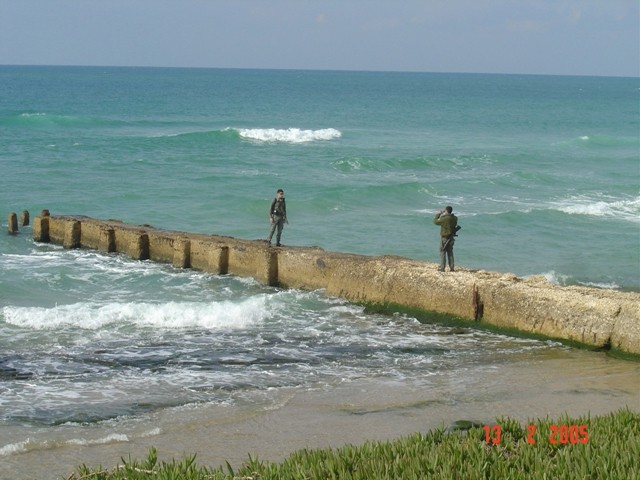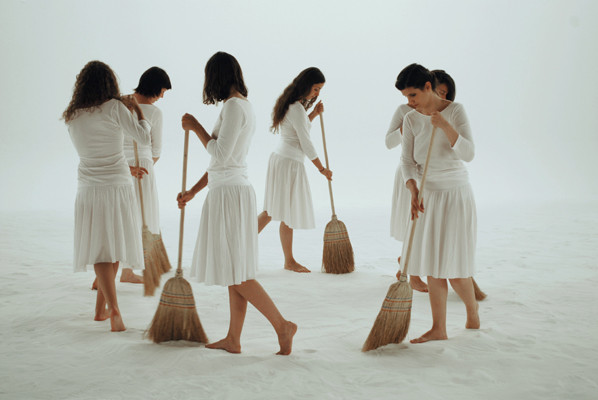Mircea Canotr: Shooting
11 Sep - 23 Oct 2010
PRESS RELEASE
Mircea Cantor- Shooting
Preview: September 7th, 2010
September 11th, 2010 – October 23rd, 2010
Dvir Gallery
MACHINE GUN IN THE MIRROR STAGE
In Mircea Cantor’s ‘Tracking Happiness’, dancers pace the sand in a circle, sweeping repeatedly the trace of each other’s steps. In its conflation of first cause and last effect, made identical in spite of the distance separating them, the film recalls Vladimir Nabokov’s observation in ‘Speak, Memory’ that the future might just be “the obsolete in reverse”. The choreographed procession in the film takes place at the phantasmal center of history that Nabokov’s phrase invites us to imagine, where the obsolete becomes itself – time past – to one side, while unfolding as the new to the other, only to be recuperated as obsolescence, as a unsettling rehearsal for a postponed conclusion. Cantor’s film takes the conventional timeline of historiography and makes it round: a loop, where the gesture is equivalent with its passage and simultaneous with its erasure, and where the tragedy equals the farce. A circular poetics, which can be understood as a space for biographies to be endlessly refashioned, or for disjunctive selves to be posited against the idea – still haunting mindsets, institutions and those political discourses predicated on apocalyptic scenarios – that time flows towards a definitive clarification of its purpose, or that the present proceeds inevitably from the past and adheres to the future as its necessary confirmation.
This remarkable video could serve as an introduction to ‘Shooting’, Cantor’s exhibition project at Dvir Gallery, Tel Aviv. Here the artist assembles an arsenal of spatial and temporal definitions, of distant realities that function as each other’s distorted reflection, obliquely defining a confrontational position. This hinges on the use of two recurrent props, the gun and the mirror, and on situating the discourse within an ambivalent scene to be ‘shot’ – photographed – and surveyed, so that dissent can be promptly stifled. A diffuse Panopticon is looking everywhere, from everywhere, armed with the instruments of both documentation and repression. It institutes its existence and efficacy via both, it is located at the blind spot and at the vanishing point; it could be said to be looking at itself, to be ensuring its permanent self-reflection. Our whole world seems organized to accommodate and guarantee this purpose: political life, in the variety of its manifestations and levels, should never interfere with this gratifying exchange, and should never block the picture.
The gun and the mirror compose in Cantor’s exhibition something of a disjointed, but nonetheless functional, camera, and interlock to take aim at the correspondences between selves, tasks and borders. The artist sets into motion categorical processes by which power defines itself as power, and business as business in another significant piece: political and economic strength seem designed to delight in their conceptual stability and instrumental effortlessness. The neon with ‘Geschäft ist Geschäft’, legible only in mirror installed on the opposite wall, sees itself in bits of broken mirror (which might indicate a previous, shattered identity) mixed with horse manure, suggesting the random glints of a diamond mine. Somewhere in the disorienting reflections, at the point where a single ‘image’ is recomposed, exchange value is extracted from a repulsive combination of elements. The exhibition imagines how life, work and worth might be defined and confined from the other side, from the perspective of an obfuscated adversary. The amounts of tragedy and irony that go into the conceptual mix are perfectly equivalent, so what had appeared as a dispirited observation is in fact an appeal to imagination: an invitation to take poetic action.
Text by: Mihnea Mircan
Mircea Cantor- Shooting
Preview: September 7th, 2010
September 11th, 2010 – October 23rd, 2010
Dvir Gallery
MACHINE GUN IN THE MIRROR STAGE
In Mircea Cantor’s ‘Tracking Happiness’, dancers pace the sand in a circle, sweeping repeatedly the trace of each other’s steps. In its conflation of first cause and last effect, made identical in spite of the distance separating them, the film recalls Vladimir Nabokov’s observation in ‘Speak, Memory’ that the future might just be “the obsolete in reverse”. The choreographed procession in the film takes place at the phantasmal center of history that Nabokov’s phrase invites us to imagine, where the obsolete becomes itself – time past – to one side, while unfolding as the new to the other, only to be recuperated as obsolescence, as a unsettling rehearsal for a postponed conclusion. Cantor’s film takes the conventional timeline of historiography and makes it round: a loop, where the gesture is equivalent with its passage and simultaneous with its erasure, and where the tragedy equals the farce. A circular poetics, which can be understood as a space for biographies to be endlessly refashioned, or for disjunctive selves to be posited against the idea – still haunting mindsets, institutions and those political discourses predicated on apocalyptic scenarios – that time flows towards a definitive clarification of its purpose, or that the present proceeds inevitably from the past and adheres to the future as its necessary confirmation.
This remarkable video could serve as an introduction to ‘Shooting’, Cantor’s exhibition project at Dvir Gallery, Tel Aviv. Here the artist assembles an arsenal of spatial and temporal definitions, of distant realities that function as each other’s distorted reflection, obliquely defining a confrontational position. This hinges on the use of two recurrent props, the gun and the mirror, and on situating the discourse within an ambivalent scene to be ‘shot’ – photographed – and surveyed, so that dissent can be promptly stifled. A diffuse Panopticon is looking everywhere, from everywhere, armed with the instruments of both documentation and repression. It institutes its existence and efficacy via both, it is located at the blind spot and at the vanishing point; it could be said to be looking at itself, to be ensuring its permanent self-reflection. Our whole world seems organized to accommodate and guarantee this purpose: political life, in the variety of its manifestations and levels, should never interfere with this gratifying exchange, and should never block the picture.
The gun and the mirror compose in Cantor’s exhibition something of a disjointed, but nonetheless functional, camera, and interlock to take aim at the correspondences between selves, tasks and borders. The artist sets into motion categorical processes by which power defines itself as power, and business as business in another significant piece: political and economic strength seem designed to delight in their conceptual stability and instrumental effortlessness. The neon with ‘Geschäft ist Geschäft’, legible only in mirror installed on the opposite wall, sees itself in bits of broken mirror (which might indicate a previous, shattered identity) mixed with horse manure, suggesting the random glints of a diamond mine. Somewhere in the disorienting reflections, at the point where a single ‘image’ is recomposed, exchange value is extracted from a repulsive combination of elements. The exhibition imagines how life, work and worth might be defined and confined from the other side, from the perspective of an obfuscated adversary. The amounts of tragedy and irony that go into the conceptual mix are perfectly equivalent, so what had appeared as a dispirited observation is in fact an appeal to imagination: an invitation to take poetic action.
Text by: Mihnea Mircan


